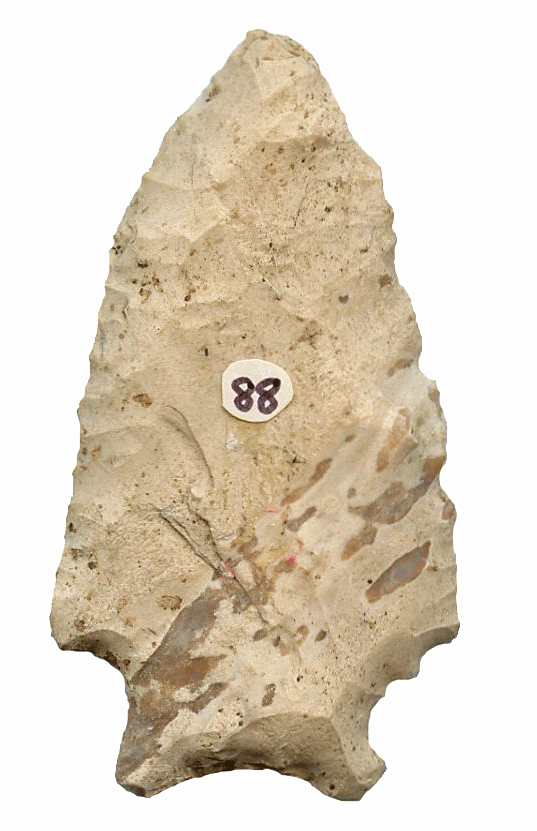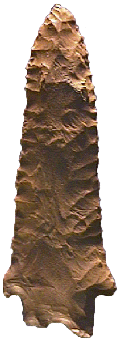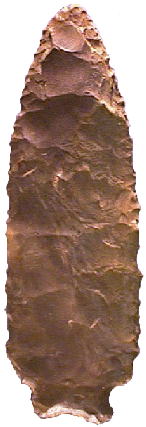





Point Type: BUZZARD
ROOST CREEK
Also See: Arredondo, Benton, Elk River, Kirk Serrated, MacCorkle, Pedernales, Southampton, Stanly, Sykes, Uvalde
Location: Southeastern United States
Associated Dates:
6500 - 4000 B.P. - Mid-Archaic
Morphology: Bifurcated
Stemmed
General Description: The Buzzard Roost Creek point is a medium to large sized Middle Archaic dart, spear point or knife blade. The type has a short, broad, bifurcated stem. The basal edges of the stem are usually rounded however some examples have sharp auricles. Many believe that it is strongly related to the Benton point type and it is a part of the Benton cluster along with the Benton and Elk River points. However, Buzzard Roost Creek points are more crudely made, their stems are shorter and the base is more concave. Also in many cases, the Buzzard Roost Creek has very wide and shallow corner notches. Some call it a notched-base Benton or a Benton Auriculate. In Ohio, Converse (1970:27) wrote of a type which may be related that he calls a "concave base corner notch". The Buzzard Roost Creek points that are found in Arkansas often have one steeply beveled edge on each side of the blade. The blade is generally triangular in outline with edges that may be excurvate, straight, incurvate or recurvate. The blade is thin in cross section.
These large points can often exhibit snap fractures, which indicate possible use as knives or spear tips where twisting or thrusting caused the breakage. Heavy edge wear on the blade edges of some examples suggests cutting or sawing motion use.
The Buzzard Roost Creek is usually found in northern Alabama, Georgia, Tennessee, in Ohio from the headwaters of the Great Miami River southwards to the Ohio River, central and southern Indiana and Kentucky.
Typical Buzzard Roost examples measure between 55 mm and119 mm in length and range between 23 mm and 36 mm in width with a thickness range of 6 mm to 10 mm. The stem length is between 10 mm and 14 mm and the stem width ranges from 17 mm to 24 mm.
The Buzzard Roost Creek was named by James W. Cambron in 1958 for examples which he recovered from the Buzzard Roost Creek site in Colbert County, Cherokee, Alabama. Stratification at the Stanfield-Worley Bluff Shelter site indicates a Middle Archaic association (DeJanette, Cambron, Kurjack 1962) with an estimated date range of 6450 B.P. - 5950 B.P. The point appears to be similar to the Sykes point which is reported in the Eva site report (1961:45) by Lewis and Kneberg.
About The Point Above (Left): The point pictured above on the left, is a small Buzzard Roost Creek point made light cream colored chert with caramel colored shiny flint inclusions. The point measures 66 mm in length, 35 mm at the widest point and is 7 mm thick at the base of the shoulders with most of the blade being 5 mm thick. The stem is 21 mm wide at the notches and is 24 mm wide at the tip of the basal ears. The base has been thinned and ground. This point was a surface find near the town of Nixon, Hardin County, Tennessee. Catalog Number 88-25-D
About The Point Above (Center): The large blade pictured above in the center, is a marvelous and large Buzzard Roost Creek blade made from a highly patinated, very dark matte reddish brown chert material. This artifact is very skillfully knapped and shows oblique transverse knapping scars on both faces of the blade. Obviously this blade has been resharpened a few times. The point measures 88 mm in length, 29 mm at the widest point which is across the barbs and is 7 mm thick at the base of the shoulders with most of the blade being 5.5 mm thick. The stem is 19 mm wide at the notches and is 19.5 mm wide at the tip of the basal ears. The base has been thinned and ground. This point is peculiar in the fact that the basal ears are not expanding and one of the basal ears is shorter than the other, however edge retouch scars show this to be an original attribute and not the result of modern chip damage. This point was found in Tennessee. Catalog Number 141-56-D
About The Point Above (Right): The large blade pictured above on the right, is a magnificent and extreamly large Buzzard Roost Creek blade made from a dark brown Buffalo River chert which has olive, tan and cream colored inclusions. The point measures 111 mm in length, 36 mm at the widest point and is only an incredible 6 mm thick at the base of the shoulders with most of the blade being 5 mm thick. The stem is 21 mm wide at the notches and is 22.5 mm wide at the tip of the basal ears. The base has been thinned and ground. This point was found near the town of Ramer, McNairy County, Tennessee. Catalog Number 85-65-D
References: Baker, Converse, DeRegnaucourt, Overstreet, Perino (1), Powell, Puckett (1, 2), Sowell & Nowak, Waldorf
© Copyright 1997 - 2008 LITHICS-Net WWW.LITHICSNET.COM
Use your Browser's BACK Button to return to the LITHICS-Net Index.